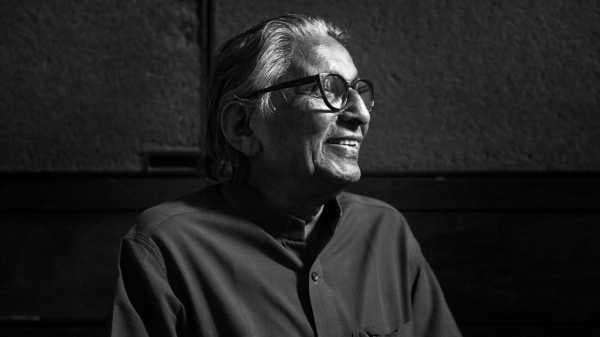
In the buildings of Balkrishna Doshi, the Indian architect who won this year’s Pritzker Prize, it’s easy to take the light for granted. Years ago, I visited the Ahmedabad campus of CEPT University, which began as an architecture school founded by Doshi. It was midsummer, and the afternoon roared with heat, but in the paths between buildings, overhangs and parapets dropped pools of shadow. The plazas were studded with neem and arjuna trees, and the design studios had sloping skylights, so that the sun was permitted only oblique entry. Most modern sections of India’s cities are all about harshness, their greenery exfoliated and the surfaces paved with naked tar and concrete. Doshi, by contrast, once said that he admired Le Corbusier’s ability “to create a soft light that makes people’s faces glow.”
A quiet, lank-haired man of ninety, Doshi is no starchitect. He hasn’t dreamed up opera houses and museums in cities around the world; he hasn’t even designed airport terminals or skyscrapers in India. Instead, in a career that has spanned seventy years, he has focussed on public institutions: universities, libraries, performance-art centers, and low-cost housing complexes. He committed early to sustainability—not necessarily out of any premonition about the environment but because to be sustainable was to be local. Doshi wanted his buildings, above everything, to be of the place where they reside, of its weather and its vegetation, and of the rhythms of its people’s lives.
When Doshi first studied architecture, in Bombay, in the late nineteen-forties, his courses taught nothing about Indian styles of building; indeed, he felt his education to be so deficient that he travelled to London, stayed with a friend, and schooled himself every day in the library of the Royal Institute of British Architects. At a conference in England, Doshi met Le Corbusier, the modernist wizard who had been commissioned to lay out the new Indian city of Chandigarh, and to design several of its buildings. Having wangled a job out of the elder architect, Doshi moved to Paris to work in his atelier, where he stayed for four years. In the newly independent India of the time, modernism was as much a political project as an architectural one. The hallmarks of Le Corbusier’s style—the shells of poured concrete, the industrial spirit, the monumentality—sang of the future, and Doshi wanted to be part of it. “Le Corbusier didn’t pay me for eight months, I had hardly any money,” he said, in a documentary about his life, in 2009. “Eight months with olives and cheese and bread, that’s all.”
The Chandigarh project, though, brought Doshi mixed satisfaction. Le Corbusier, he later said, was new to the challenges of building in India—“the relentless sun, the hot winds . . . the fury of the monsoon.” Realizing that his designs had to have “a pact with nature,” Le Corbusier set about breaking the fierce stare of the sun, and he introduced ways for air to flow through his structures. Yet his buildings—a legislative assembly, a courthouse, a secretariat, and several others—looked as if they’d been imported whole and plunked down in India; they bore no relationship to the country around them. The city plan discouraged mixed-income neighborhoods and street bazaars, both vital to the character of Indian towns. Chandigarh had streets and open spaces, Doshi realised, but it had no life.
Doshi’s first projects nevertheless retained many of Le Corbusier’s influences. An archive called the Institute of Indology, shaped as an ark-like refuge for the manuscripts within, was an edifice of modernist concrete. Its corridors, looping around the outside of the building, were open to the air; the basement allowed natural light, tempered to a Corbusian softness. But Doshi felt that his buildings looked foreign, that they had no roots in the soil. “He switched to using more bricks, the kind found in this part of the world,” Nimish Patel, a fellow-architect in Ahmedabad, told me. “He reduced the scale. Most of his buildings are quite humane, not as large as Le Corbusier’s.” Doshi wanted his structures to be spaces for communal interactions—to host, as he put it in a talk in 1981, “the relations of classes and communities in their depth, their mutual actions and reactions. In short, the whole web of life.”
In Ahmedabad, in 1982, Doshi installed the Mahatma Gandhi Labour Institute as a series of linked buildings, their roofs all made of half-cylinders so that they looked like crouched terrapins; every exit seems to lead to a terrace or a plaza, a space for people to lounge and converse. Laying out a satellite city near Jaipur, in 1984, he included tanks to harvest rainwater, and he prized the needs of pedestrians above motorists. The Doshi opus I’ve visited most often is the Indian Institute of Management, in Bangalore, a business-school campus that defies the commercialism of the subjects being taught in its rooms. The school’s graduates will go on to work in steel-and-glass skyscrapers around the world, but as students they spend their time in buildings modelled on an ancient temple that Doshi had once visited. He clad the walls in solemn gray granite, and he incorporated columns of stone and long, open corridors charged with breeze and bathed in beams of near-sanctified sunlight. Most of the campus was given over to woodlands, so following the paths through the trees to the buildings is like stumbling upon a shrine in a forest.
Doshi encourages his projects to take on lives of their own, even when it happens in ways he couldn’t have predicted. In Indore, in 1989, invited by an official in the city to construct a landmark building of his choice, he opted instead to design a township for eight thousand low-income families. (He had written in his diary, in 1954, “It seems that I should take an oath and remember it for my life-time: to provide the lowest class with the proper dwelling.”) In the township, called Aranya, subsidized patches of land were sold to poor families; Doshi offered a batch of model homes for inspiration, but encouraged families to plan and build their own houses. Some of the plots were instead purchased and flipped for profit, but Doshi didn’t mind. “Some people built a second floor and leased that out, and others started shops or cottage industries on their plots of land,” he told me recently. “All this was unexpected. It was like I’d given them a kit of parts, and they’d found ways to use it. But they were empowered, they grew.”
Doshi was not alone in infusing Le Corbusier’s modernism with an Indian spirit. A small school of other architects—Charles Correa, Ranjit Sabikhi, Raj Rewal—joined him in this idiom between the nineteen-sixties and the eighties. The Indian state was still building itself out, so there were plenty of public commissions on offer, and the socialist temper of the times agreed with these architects’ interest in planning for utopia. They were displaced only a couple of decades ago, when the country’s economy opened up and a global design aesthetic blew in. Commissions now come from companies that seem to want their buildings to fit into a universal ideal of a central business district. The most ambitious government-funded project in decades—the design of Amaravati, a new state capital—lies in the hands of the world-trotting English starchitect Norman Foster.
India isn’t always a pleasant country for architects. “In some way, architecture has been associated with the country’s urban problems,” Gautam Bhatia, an architect in New Delhi, told me. “The housing is insufficient, the infrastructure is insufficient. When you have these problems, is it even ethical to worry about design? There’s a strange guilt the profession harbors.” Most architects, as a result, work on private commissions, Bhatia said.
But Doshi professes bafflement that any Indian architects are able to detach themselves from the realities of average Indians. In an interview a few years ago, Bhatia asked him about the gleaming glass towers and hotels being flung up in every Indian city. Doshi acidly called them “pure imitation,” quick to be erected but lacking in “virtue.” In our recent conversation, Doshi told me that architecture should be informed not by an “aesthetics of affluence” but by empathy: “If you walk down the street and see the people, don’t you immediately feel, ‘What can I do for them?’ ”
Sourse: newyorker.com






